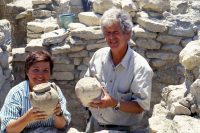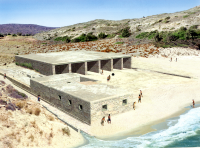
Photo by Kostis Voutirakis, site of Palaikastro, 2014, courtesy of British School at Athens excavations.

Joseph and Maria Shaw holding Minoan pottery recovered from a house at Kommos.

Restored shipsheds at Kommos, Crete, for storing long rowed ships of the Minoan fleet.
Graduate study in Ancient Art at the University of Toronto concerns the material, artistic, and visual cultures of the ancient Mediterranean, Western Europe, and Southwest Asia. Our faculty and students work on topics ranging from the archaeology of Minoan Crete, Greek vase painting and sculpture, as well as architecture, to the art(s) of the Roman Empire – and including geographical interests in the Near East and Gandhara. We employ a great diversity and heterogeneity of approaches and methods. Some are intrinsic to the discipline and have historically evolved in an engagement with the objects they seek to explain; others are shared with or appropriated from related fields in the humanities and social sciences. Digital archaeology and the application of advanced imaging methods are a complementary area of faculty expertise. In the ancient art graduate program, students thus engage with a variety of methodological approaches, from cutting-edge scientific methods in archaeology to critical theories in visual and cultural studies. Meanwhile, we also encourage cross-disciplinary training in related fields such as Classical studies, anthropological archaeology, religious studies, critical theory, women’s studies, and digital humanities.
The Department has a background in archaeology, especially that of the Greco-Roman area. Homer Thompson, for instance, took charge of excavation in the Athenian Agora (1931‒1970). Later, J. Walter Graham became an expert on Greek housing before turning to the Minoan Palatial world (1947‒1967); and Frederick Winter excelled in his knowledge of Greek Hellenistic architecture (1957‒2011). More recently, Joseph W. and Maria C. Shaw discovered a unique prehistoric Minoan port at Kommos in Crete, which became the first large-scale Canadian excavation in Greece. The Kommos site has now been published completely in ten volumes. Carl Knappett is currently co-director of the ongoing archaeological explorations at Palaikastro, a longstanding project in east Crete sponsored by the British School at Athens.
The faculty members in ancient art represent four main areas: Carl Knappett (Aegean prehistory), Philip Sapirstein (Architecture), SeungJung Kim (Greek), and Björn C. Ewald (Roman). Our research areas are diverse, but are united by a common interest in ancient spatialities from the local to the global, concepts of time and temporality and their relationships to the visual arts, art and subjectivity, phenomenological approaches to ancient art, and the ontological standing of ancient material and visual culture.
Graduate coursework in the field of ancient art seeks to engender and enhance a critical understanding of art and artefacts in their materiality as well as in their broader political, social and ritual contexts; of the ideological implications of art and architecture as well as their emotional investments; of their temporality and narrative; and of urbanism and spatiality. Our graduate courses usually have a conceptual or theoretical orientation that makes them well suited for students of other fields and periods of art history. Graduate students in ancient art have the opportunity to take part in fieldwork in the Mediterranean, work in the Aegean Material Culture Laboratory, and participate in the numerous seminars offered by the Archaeology Centre, which also funds student travel and provides unparalleled access to digital equipment. They are encouraged to participate in the Mediterranean Archaeology Collaborative Specialization (MACS), an interdisciplinary program that provides training in methods, connects students with fieldwork opportunities, and hosts a wide range of events on campus and beyond. Robarts Library has superb resources for the study of ancient art, and the nearby Royal Ontario Museum (ROM) houses collections of Aegean Bronze Age, Greek, and Roman material.
| Faculty | Areas of Interest |
|---|---|
| Björn C. Ewald | Ancient art |
| SeungJung Kim | Greek art and archaeology |
| Carl Knappett | Aegean Bronze Age |
| Philip N. Sapirstein | Greek, Roman and Near Eastern art and architecture; Digital humanities; Ceramics; Greeks and the East |


